
Bolt-action is a type of manual firearm action that is operated by directly manipulating the bolt via a bolt handle, most commonly placed on the right-hand side of the firearm. The majority of bolt-action firearms are rifles, but there are also some variants of shotguns and handguns that are bolt-action. A firearm using bolt-action mechanism is colloquially referred to as a bolt gun.

In firearms terminology, an action is the functional mechanism of a breech-loading firearm that handles the ammunition cartridges, or the method by which that mechanism works. Actions are technically not present on muzzleloaders, as all those are single-shot firearms with a closed off breech with the powder and projectile manually loaded from the muzzle. Instead, the muzzleloader ignition mechanism is referred to as the lock.

The Colt AR-15 is a lightweight, magazine-fed, gas-operated semi-automatic rifle. It is a semi-automatic version of the M16 rifle sold for the civilian and law enforcement markets in the United States. The AR in AR-15 stands for ArmaLite rifle, after the company that developed it in the 1950s. Colt's Manufacturing Company currently owns the AR-15 trademark for its line of semi-automatic AR-15 rifles.
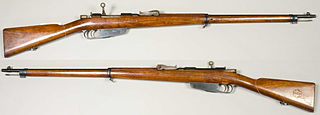
Carcano is the frequently used name for a series of Italian bolt-action, internal box magazine fed, repeating military rifles and carbines. Introduced in 1891, the rifle was chambered for the rimless 6.5×52mm Carcano round. It was developed by the chief technician Salvatore Carcano at the Turin Army Arsenal in 1890, and was originally called the Modello (model) 91 or simply M91. Successively replacing the previous Vetterli-Vitali rifles and carbines in 10.35×47mmR, it was produced from 1891 to 1945. The M91 was used in both rifle (fucile) and shorter-barreled carbine (moschetto) form by most Italian troops during World War I and by Italian and some German forces during World War II. The rifle was also used during the Winter War by Finland, and again by regular and irregular forces in Syria, Libya, Tunisia, and Algeria during various postwar conflicts in those countries.

A magazine, often simply called a mag, is an ammunition storage and feeding device for a repeating firearm, either integral within the gun or externally attached. The magazine functions by holding several cartridges within itself and sequentially pushing each one into a position where it may be readily loaded into the barrel chamber by the firearm's moving action. The detachable magazine is sometimes colloquially referred to as a "clip", although this is technically inaccurate since a clip is actually an accessory device used to help load ammunition into a magazine or cylinder.
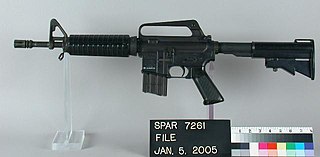
The Colt Automatic Rifle-15 or CAR-15 is a family of M16 rifle–based firearms marketed by Colt in the 1960s and early 1970s. However, the term "CAR-15" is most commonly associated with the Colt Commando ; these select-fire carbines have ultrashort 10.5-inch (270 mm) and 11.5-inch (290 mm) barrels with over-sized flash suppressors.
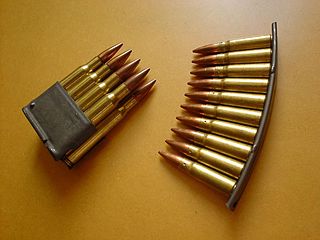
A clip is a device that is used to store multiple rounds of ammunition together as a unit for insertion into the magazine or cylinder of a firearm. This speeds up the process by loading the firearm with several rounds at once, rather than one at a time. There are several types, most made of inexpensive stamped sheet metal, intended to be disposable, though they are often re-used.

The Mannlicher M1895 is a straight pull bolt-action rifle, designed by Ferdinand Ritter von Mannlicher that used a refined version of his revolutionary straight-pull action bolt, much like the Mannlicher M1890 carbine. It was nicknamed the Ruck-Zuck-[Gewehr] by Austrian troops and "Ta-Pum" by Italian troops who wrote a song (it) about it during World War I. The primary producers were the ŒWG in Steyr, and FÉG in Budapest.
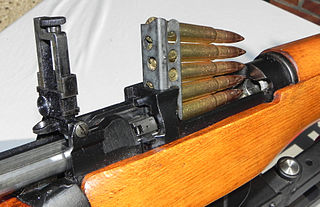
A stripper clip is a speedloader that holds several cartridges together in a single unit for easier and faster loading of a firearm magazine.
The karabinek wzór 1988 Tantal is a 5.45×39mm assault rifle designed and produced in Poland in the late 1980s.

The Gewehr 98 is a bolt-action rifle made by Mauser for the German Empire as its service rifle from 1898 to 1935.

The Gewehr 88 was a late 19th-century German bolt-action rifle, adopted in 1888.
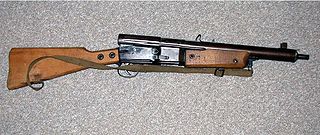
The Volkssturmgewehr is the name of several rifle designs developed by Nazi Germany during the last months of World War II. They share the common characteristic of being greatly simplified as an attempt to cope with severe lack of resources and industrial capacity in Germany during the final period of the war. The Volkspistole was a partner program, almost identical, but for pistols instead.

"Swedish Mausers" are a family of bolt-action rifles based on an improved variant of Mauser's earlier Model 1893, but using the 6.5×55mm Swedish cartridge, and incorporating unique design elements as requested by Sweden. These are the m/94 carbine, m/96 long rifle, m/38 short rifle and m/41 sniper rifle. Production began in 1898 at Carl Gustafs stads Gevärsfaktori in Eskilstuna, Sweden.
The StG 45(M) (abbreviation of Sturmgewehr 45, "Assault Rifle 45") sometimes referred to as the MP 45(M), was a prototype assault rifle developed by Mauser for the Wehrmacht at the end of World War II, using an innovative roller-delayed blowback operating system. It fired the 7.92×33mm Kurz (or "Pistolenpatrone 7.9mm") intermediate cartridge at a cyclic rate of around 450 rounds per minute.
The evolution of German military rifles is a history of common and diverse paths followed by the separate German states, until the mid-19th century when Prussia emerged as the dominant state within Germany and the nation was unified. This article discusses rifled shoulder arms developed in or for the military of the states that later became Germany; it excludes firearms of the Austrian Empire, except where they were used substantially by German troops.
The Mauser Model 1893 is a bolt-action rifle commonly referred to as the Spanish Mauser, though the model was adopted by other countries in other calibers, most notably the Ottoman Empire. The M1893 was based on the experimental M1892 rifle, which Paul Mauser developed for the Spanish Army as part of a program to correct deficiencies in the earlier 1889, 1890, and 1891 series of Mauser rifles. The M1893 introduced a short staggered-column box magazine that fit flush with the bottom of the stock; the magazine held five smokeless 7×57mm Mauser rounds, which could be reloaded quickly by pushing a stripper clip from the top of the open bolt.

The Mauser Model 1889 is a bolt-action rifle of Belgian origin. It became known as the 1889 Belgian Mauser, 1890 Turkish Mauser, and 1891 Argentine Mauser.
The Fusil Automatique Modèle 1917, also called the RSC M1917, was a gas-operated, semi-automatic rifle placed into service by the French Army during the latter part of World War I. It was chambered in 8mm Lebel, the rimmed cartridge used in other French Army infantry weapons of the time. In total, the French national armories, primarily Manufacture d'armes de Saint-Étienne (MAS) and Manufacture Nationale d'Armes de Tulle (MAT), manufactured 86,000 RSC M1917 rifles until production ended in late November 1918. However, very few examples have survived in fully functional, semi-automatic condition and those have become highly sought-after collectibles.

The Mauser Model 1895 is a bolt operated magazine fed rifle using the 7×57mm Mauser cartridge. It was exported to many overseas powers, including the Chilean forces which adopted as the Fusil Mauser Chileno Modelo 1895. It is the first major modification of the Mauser Model 1893 and was produced by Deutsche Waffen und Munitionsfabriken, known as DWM, and Ludwig Loewe Company from 1895 to 1900.















